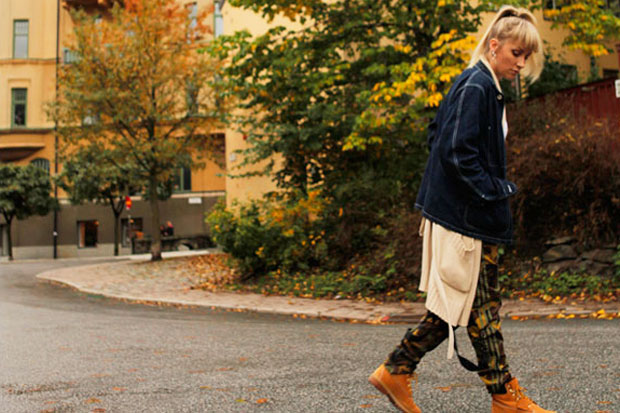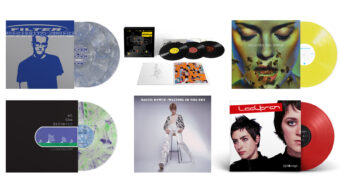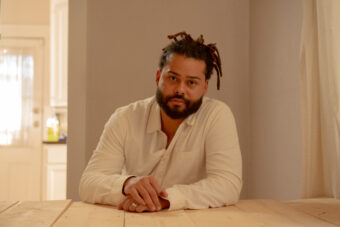Maria “Decida” Wahlberg might well be one of the most creative people in Sweden, but it’s not a simple task to encapsulate what she does. She’s a fashion plate and impeccable dresser who seamlessly integrates her personal style with the music culture she came up on. She can elevate the Hammer-pant concept with a Damir Doma trouser and black Air Force 1s. She rocks Timbalands with kente pants and a denim jacket like nobody’s business, and, best of all, she realizes that Jody Watley is an underrated style icon — and has styled photo shoots accordingly.
Wahlberg’s aptitude for looking fly has landed her styling and design jobs all over Sweden, mostly with musicians. And though she started out with Beats Melodier & Baby Kaah’s 2001 album cover, lately, she’s better known as the stylist for pop star Robyn. Those platform Timbs, custom belts, and patchwork moto jackets you see her in? All Decida. The choreography for the single shot “Call Your Girlfriend” video? Decida, because oh yeah, she’s also an insane dancer, as seen in this ’06 freestyle or in a more recent vogue battle — which she did while wearing a shiny batik catsuit and pristine white blazer. Get-In-My-Closet Realness, nahmean?
Decida’s also the editor, creative director, and founder of the website 2FACED1, dedicated to “taking you on a journey through transnational identities, style, and stereotypophobes.” That means gorgeous style photos with insightful interviews and features that explore identity, race, class, ethnicity, gender, etc., with an eagle-eye cast toward progress and the future. She also hosts blogs, including her own — a crucial stop for both style archivists and Robyn fanatics — as well as that of her friend Spoek Mathambo, who posts very infrequently but has a deep archive of musings on music, his travels, and tours, as well as politics around the world. Right now, she’s preparing a video treatment, choreographing and styling an art and dance film, no big deal. Here, a conversation with a true designing woman.
[Correction: The dancer in the video is actually Anna Ninja, of House of Ninja, who is styled by Decida. This does not change how we feel about the outfit.]
What’s your first distinct memory of noticing how people dressed?
Music videos with Madonna and Michael Jackson for sure.
When did you know you wanted to be a stylist?
I never really wanted to be specifically a stylist to be honest, but I’ve always been interested in clothing in a context, as codes, as a tool to tell people something about how you want them to perceive you. I started to style when some friends, artists, needed help and felt I understood what they were after.
You are also an incredible dancer — how did you first get into it?
Thank you, but I don’t know about that nowadays though, the body is kind of aching nowadays! I’ve been dancing all my life, and it was my main focus for a couple of years. But the life of a dancer is hard, and there are too much fun things out there to just focus on one discipline.
You’ve done a lot of awesome editorials on the style of Jody Watley, Sade, etc. And you’re so intimately tied into the intersection between music and fashion. How did those two interests come together for you?
Music is my first love, I wouldn’t be dancing or working with the visual aspects of music if it wasn’t for the music. If I should really trace it down to the core, I was into the escapism that a subculture based on music could supply — the early ’90s rap scene, back when listening to hip hop basically was a political statement. It was and is a whole world for me. I wanted to learn to master the visual language of that world. Music has an unmatched way to capture the zeitgeist, I’m interested in transforming sounds into style.
What was your upbringing like?
I’m from Uppsala, a city with a really old university that brought both intellectuals and immigrants from all over the world together. We were fortunate to grow up in a social democratic Sweden that still had some of the late Olof Palme’s spirit in it. I have a love-hate relationship with the city, ’cause it never validated the pop culture I hold so dear, but there are tons of great people coming out of Uppsala. Ask Robyn!
Okay! How did you first link up with Robyn? How do you work together, clothing wise — have you learned her style or do you see eye-to-eye?
Stockholm is not that big, we met through a mutual friend, Louise, and I heard Robyn read my blog. When she started creating the Body Talk albums she knew they would involve a lot of dance music so she just wanted my opinion on how dance could be a part of that. We took a coffee and clicked, one thing led to another.
You’ve customized some really excellent pieces for her, including the belts. You did the platform Timbs, right? What inspires you creatively when it comes to designing your own stuff?
The thing with Sweden is we basically just have Acne and H&M. You’ve got to be creative, cause you can’t just step into a great showroom and pick out great stuff like in London, Paris and NYC.
What was the idea behind 2FACED1?
To be a two-faced-one is a state of mind. A 2FACED1 is a person who understands how different power structures in the society co-exist, and that you could be the superior and inferior at the same time (in the Academic world this is known as Intersectionality). Identity is created in context, not inherited, and the 2FACED1 sees self-awareness as a talent to understand other peoples struggles instead of getting caught up in “oppression Olympics.” The site 2FACED1.com is a simple window display of this more fluid way of looking at identity as something contextual.





